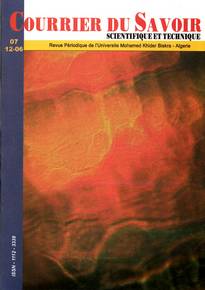CONTRIBUTION À L’OPTIMISATION DE LA CONCEPTION GLOBALE EN CONSTRUCTION MÉTALLIQUE CONTRIBUTION TO THE OVERALL CONCEPTUAL DESIGN OPTIMISATION OF STEEL STRUCTURES
Résumé
Outre le dimensionnement des éléments porteurs principaux, laconception des assemblages et des appuis peut influer d’une
façon considérable sur les caractéristiques techniques et économiques des projets de Construction Métallique. Cependant, les
contraintes de temps et de ressources obligent les concepteurs à limiter le nombre de configurations à considérer en phase
précoce de conception ce qui rend difficile l’optimisation globaledes coûts de réalisation des structures. Nous proposons, dans
cette première publication, une formulation du problème complexe d’optimisation de la conception globale des structures
métalliques. La fonction objectif tient compte des coûts matière et réalisation des différents éléments de la structure. Les
contraintes de conception sont formulées à la base de la réglementation Eurocode 3 et des documents techniques
réglementaires DTR Algériens. Trois variables de conception sont considérées : les caractéristiques dimensionnelles des
différents éléments, le type des assemblages et le type des appuis. Différents types d’assemblages sont considérés. Un modèle
simplifié est utilisé pour estimer les caractéristiques des assemblages semi-rigides.
In addition to the cross-sectional size of the structural members, the type of connections and supports plays an important rolein
the analysis and design of steel structures and affects considerably its whole production cost. However, due to time and
resource constraints, structural designers tend to limit the range of alternative configurations considered especially in early
design stage. In this first paper, a formulation of the optimization problem is presented for the overall design of steel structures.
The objective of the proposed method is to identify the optimum configuration and cross-sections of a building steel structure
according to adequate foundations. In the objective function, the material and manufacturing costs are taken into account. The
design constraints are formulated according to Eurocode 3 and to Algerian regulation technical documents DTR. Three design
variables are considered: members cross-sectional size, the type of beam-to-column connections and the type of supports. A set
of standard beam-to-column connections is considered and a simplified model is used to include the moment-rotation relation
of semi-rigid joints
Références
environnementale des bâtiments, Paris, France, 1997.
[2] D. Beasley, D.R. Bull et R.R. Martin (1993), Al
overview of Genetic Algorithms: Part1,
Fundamentals, University Computing Journal, Vol.15,
N°2, p58-59.
[3] N. Bel hadj ali, J-C. Mangin, A-F. Cutting Decelle
(2002), Optimisation of steel structures design with
genetic algorithms, Proc. of 3
rd
international
conference in decision making in urban and civil
engineering, London, U.K., 825-831.
[4] Centre National de Recherche Appliquée en Génie
Parasismique CGS (2004), Règles Parasismiques
Algériennes RPA 99 version 2003, publication du
Contribution à l’optimisation de la conception globale en construction métallique
35
CGS, Alger, Algérie.
[5] Centre Technique Ind. de la Construction Métallique
CTICM (1996), Assemblages flexionnels en acier
selon l’Eurocode 3, édition du CTICM, St Rémy les
Chevreuse, France.
[6] P.G. Ciarlet (1990), Introduction à l’analyse
numérique matricielle et à l’optimisation, édition
Masson, Paris.
[7] A. Colson, J.M. Hottier, A. Moricet (1996), Modèles
simplifiés d’assemblages semi-rigides – Analyse
comparative, Revue Construction Métallique N° 4-1996, p55-67, édition du CTICM, St Rémy les
Chevreuse, France.
[8] Comité Européen de Normalisation CEN (2005),
Profilés Européens laminés, Bruxelles, Belgique,
http://www.cenorm.be
[9] Comité Européen de Normalisation CEN (1992),
Design of steel structures, Eurocode 3 part 1.1,
European Pre-Standard ENV 1993-1-1, Bruxelles,
Belgique.
[10] E.P. Deiman, H.T. Platt (1993), Cost Information in
Succeeding Stages of the Design Process, proc. 4
th
EuropIA International Conference on the Application
of AI, Robotics and Image Processing (Advanced
Technologies), Elsevier Science Publisher, 402-412.
[11] H.G.A. Evers, IR.F. Maatje (2000), Cost based
engineering and production of steel constructions,
proc. 4
th
international workshop on connections in
steel structures, Roanoke, VA, USA, 14-23.
[12] D.B. Fogel (1997), Evolutionary Computation : A
New Transactions, IEEE Transactions on
Evolutionary Computation , vol. 1, n°1, p. 1.
[13] Guide de conception et de réalisation (1993),
Construire en acier, publications du Moniteur, Paris,
France.
[14] M. Hamchaoui (1997), Conception économique des
assemblages en Construction Métallique. Thèse de
doctorat en génie civil, Université de Savoie, France.
[15] F. Hayes-Roth, D. Waterman, D.Lenat (1983),
Building Expert Systems, édition Addison-Wesley.
[16] J.P. Jaspart, D. Vandegans (1997), Application de la
méthode des composantes aux pieds de poteaux,
Revue Construction Métallique N° 2-1997, p3-17 et
N° 3-1997 p3-13, éditions du CTICM, St Rémy les
Chevreuse, France.
[17] P. Jayachandran (2003), Design of tall buildings:
Preliminary Designand Optimisation, International
Conference on Tall Buildings and Industrial
Structures, Coimbatore, India, Keynote Lecture
(Conférence Invitée).
[18] S. Khajehpour (2001), Optimal Conceptual Design of
High-Rise Office Buildings, PhD thesis in civil
engineering, Waterloo University, Ontario, Canada.
[19] J.P. Nougier (1987), Méthodes de calcul numérique,
édition Masson, Paris.
[20] P.Y. Papalambros (2002), The optimization paradigm
in engineering design. Journal Computer-Aided
Design, N°34-2002, p939-951,Elsevier Science
Publisher.
[21] M.Y. Rafiq (2000), A design support tool for optimum
building concept generation using a structured
genetic algorithm. International Journal of Computer
Integrated Design and Construction, Volume 2-2000,
N°2, 92-102.
[22] B. Roy (1985), Méthodologie multicritère d’aide à la
décision, édition Economica, Paris France.
[23] S. Sellami, J-C. Mangin, A-F. Cutting Decelle (2000),
Recherche de règles de conception globale des
fondations et de la superstructure en Construction
Métallique, Revue Construction Métallique N° 1-2000, p5-12, édition du CTICM, St Rémy les
Chevreuse, France.
[24] M. Steenhuis, K. Weynand, M. Gresnigt (1998),
Strategies for economic design of unbraced steel
frames. Journal of Construction Steel Researches,
46(1): 88-89, AISC, USA.
[25] W.MK. Tizani, D.A. Nethercot, G. Davies, N.J.
Smith, T.J. Macarthy (1996), Object-oriented
fabrication cost model for the economic appraisal of
tubular truss design, Advances in Engineering
Software Journal, N° 27, 11-20.


